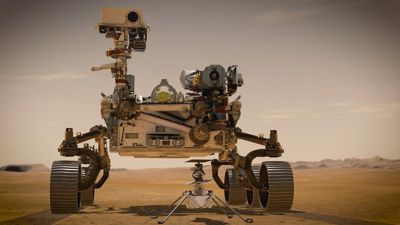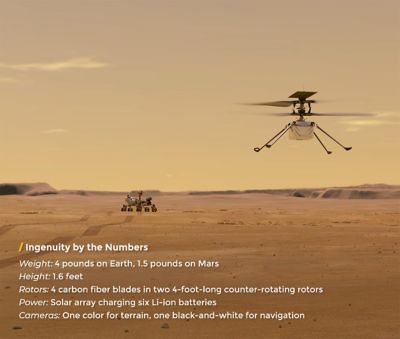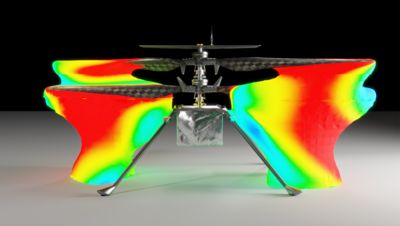ANSYS BLOG
April 8, 2021
How Simulation Is Helping Make History: The First Flight Attempt on Mars
An illustration of the NASA Perseverance rover and Ingenuity helicopter on Mars. Credit: NASA/JPL-Caltech
NASA is making history with a 4-pound (1.8 kg) helicopter named Ingenuity. The world is about to witness an attempt of the first powered flight on another planet.
NASA’s Perseverance rover, where Ingenuity was stored, touched down on Martian soil on Feb. 18, 2021. On April 4, the Perseverance rover dropped Ingenuity onto the surface of the Red Planet. NASA plans for the helicopter to take flight along the surface of the Jezero Crater no sooner than April 11 with a series of flights over a 31-day window.
It is difficult to anticipate the potential challenges of flying on Mars. Simulation and wind tunnels are critical to flight tests because they can replicate what an aircraft will experience. Accurate recreation of another planet’s gravity and atmosphere on Earth is nearly impossible, so the key to a successful maiden flight will be simulations that are truly out of this world.
The Challenges of Flying on Mars
The main challenge to Mars flight is the very thin atmosphere. The world altitude record for helicopter flight on Earth is held by Frenchman Frédéric North1 at 42,500 feet. The air at that stratospheric level is so thin that North’s helicopter rotors could no longer lift him higher. On the surface of Mars, the atmospheric density is equivalent to Earth at 100,000 feet. The Ingenuity helicopter will rely on a light design, large coaxial rotors and the lower Martian gravity to fly in such extreme conditions.
The Martian flight environment is vastly different from Earth’s:
- Density 1% of Earth’s
- 95% carbon dioxide
- Gravity a third of Earth’s
- Average temperature of -60 C (-76 F), with nights as cold as -90 C (-130 F) at Jezero Crater
Once Ingenuity leaves the ground, maintaining directional control in such a thin atmosphere is the big concern. To avoid crashing, continuous corrections are required to rotor pitch, roll and angle of attack on a millisecond-by-millisecond basis. Simulation of the advanced flight control systems is the key to safe flights on Mars, but this requires accurate aerodynamic data.
Flight on Mars may be theoretically possible, but will there be enough control to let it succeed?
An illustration of NASA’s Ingenuity helicopter flying on Mars. Credit: NASA/JPL-Caltech
Making Martian Flight Possible with Ansys Fluent
How could NASA be sure they have a helicopter that is going to make the trek to Mars and have a chance of flying? Ansys Fluent.
According to a research paper2, Fluent was used to calculate the aerodynamic forces on the rotor blade. To predict these forces, the rotor blade was divided into many slices that included span, chord, twist and sweep.
Coefficients of lift, drag and pitch moment as a function of angle of attack and Mach number were then calculated. These values were tabulated and used for helicopter flight dynamics modeling at NASA.
The simulation above5 shows massless tracer particles that highlight the impact of the rotors as they slice through the atmosphere. The tracer particles are colored by velocity. We should see maximum velocity (red color) at the rotor and near the tips. We should see lower velocity as the particles make a spiral path to the ground plane. As the rotors pass by one another, we should not see the particles from the lower rotor being pulled up or disturbed by the upper rotor. We want to keep the interaction between the counter-rotating air currents pulled by the rotors to a minimum to ensure maximum lift for the helicopter.
Why not a Quadcopter?
Ingenuity's rotors are arranged co-axially, which is not the popular quadcopter layout of many Earth-bound drones. Why is this?
The main reason for coaxial rotors on Ingenuity is efficiency.
An Ansys simulation showing zones of high pressure under the Ingenuity helicopter rotors.
The image above depicts zones of high pressure under the rotors. Pressure zones under the lower rotor are larger because the upper rotor has already compressed the thin Martian atmosphere. This phenomena allows the lower rotor to provide more lift. A quadcopter, with its four independent rotors, does not have this advantage. Additionally, a quadcopter would be slightly heavier for the amount of thrust produced. Extra rotor supports and multiple motors add weight. Finally, a quadcopter would have difficulty being stowed and then unfolded from the belly of the Perseverance rover.
Records Already Broken
Ingenuity is what is known as a technology demonstration – a project that seeks to test a new capability for the first time, with limited scope, according to NASA. If successful, it will have been the result of more than six years of work by engineers on the Ingenuity team.
They have already demonstrated that it is theoretically possible to build an ultra-lightweight craft that could generate enough lift in Mars’ thin atmosphere to take off from the ground, and operate and survive autonomously in the challenging Martian environment. As NASA says: These accomplishments have already pushed the boundaries of flight.
“When NASA’s Sojourner rover landed on Mars in 1997, it proved that roving the Red Planet was possible and completely redefined our approach to how we explore Mars. Similarly, we want to learn about the potential Ingenuity has for the future of science research,” said Lori Glaze, director of the Planetary Science Division at NASA Headquarters via a press release. “Aptly named, Ingenuity is a technology demonstration that aims to be the first powered flight on another world and, if successful, could further expand our horizons and broaden the scope of what is possible with Mars exploration.”
This is an exciting time to watch as simulation and science redefine planetary exploration.
Additional Resources
2. Flight Dynamics of a Mars Helicopter
4. NASA Ingenuity Mars Helicopter Prepares for First Flight
5. Disclaimer: The simulation video an images were created from a geometry Ansys redrew from the public domain model of the helicopter and was run and post processed by an Ansys engineer. NASA JPL was not involved in their creation.


